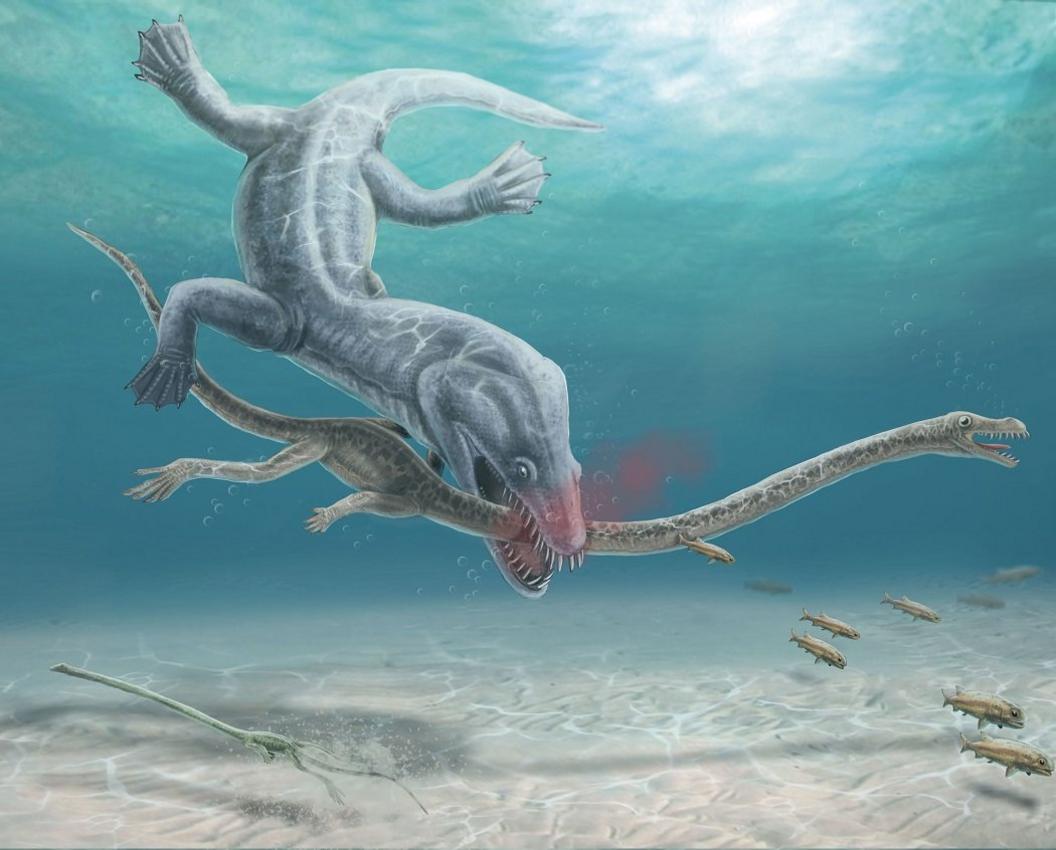Prehistoric reptiles' long necks made them targets for predators
- Published
- comments

Tanystropheus' long necks made them likely targets of predators
Researchers have been trying to figure out whether a species of reptile that lived during the dinosaur age became prey because of their long necks for almost 200 years.
Now, a new study suggests this may have indeed been the case, with their extremely long necks making them likely targets of predators.
In fact, these reptiles may have come to quite a gruesome end according to the research, with their necks being bitten and even broken by other hungry animals.
For the study, researchers looked at the fossils of the unusual necks of two Triassic species of Tanystropheus, a type of reptile which is distantly related to crocodiles, birds, and dinosaurs.
The species had unique stiffened necks which were made up of 13 extremely long vertebrae, which are the backbones of the spine.
One of the necks studied belonged to a smaller species of Tanystropheus which would have been about a metre and a half in length and is likely to have eaten soft-shelled animals like shrimp.
The second fossil belonged to a much larger species which measured up to six metres long and fed on fish and squid.
Tanystropheus is a type of reptile distantly related to crocodiles
It's thought the animal's predators took advantage of their long necks.
Studies of the fossilised bones of the two species show they have clear bite marks on them. On one of the fossils, the bite marks appear right where the neck is thought to have been broken.
"Paleontologists speculated that these long necks formed an obvious weak spot for predation," said Stephan Spiekman from the Stuttgart State Museum of Natural History in Germany.
"Nevertheless, there was no evidence of decapitation - or any other sort of attack targeting the neck - known from the abundant fossil record of long-necked marine reptiles until our present study on these two specimens of Tanystropheus."
Tanystropheus lived millions of years ago
Although it was known that the two fossils of these species had heads and necks that ended suddenly suggesting they'd been bitten off by a predator, no one had looked at this in detail up until this latest study.
"Only the neck and head are preserved; there is no evidence whatsoever of the rest of the animals," said Eudald Mujal, who is also from the Stuttgart State Museum, and a research associate at the Institut Catala de Paleontologia Miquel Crusafont in Spain.
"The necks end abruptly, indicating they were completely severed by another animal during a particularly violent event..."
He also believed the heads and necks weren't actually eaten by the predators.
"The fact that the head and neck are so undisturbed suggests that when they reached the place of their final burial, the bones were still covered by soft tissues like muscle and skin.
"Although this is speculative, it would make sense that the predators were less interested in the skinny neck and small head, and instead focused on the much meatier parts of the body."
Watch this animation all about how dinos died out.
The findings seem to suggest sea reptiles which evolved to have a long and stiff neck like this may have experienced some negative consequences as a result, although it wasn't all bad news.
"The advantage of having a long neck clearly outweighed the risk of being targeted by a predator for a very long time," said Dr Spiekman.
"Even Tanystropheus itself was quite successful in evolutionary terms, living for at least 10 million years and occurring in what is now Europe, the Middle East, China, North America, and possibly South America."
- Published7 August 2020
- Published10 October 2022
- Published15 April 2021
